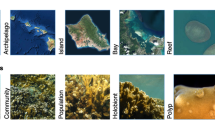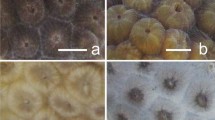Abstract
Spectral reflectance (R) of corals is a fundamental parameter to coral reef remote sensing. We explore general trends as well as geographic and taxonomic variabilities of coral R using a data set consisting of 5,199 R’s measured in situ at depths of up to 15 m for 195 coral colonies at 11 sites worldwide. Coral R ranges in magnitude from ~0.5% at 400 nm to near 100% at 700 nm; mean coral R rises from ~2.5% at 400–500 nm to ~8% between 550 and 650 nm. All corals measured in this study exhibit one of two basic shapes of R, which we label the “brown” and “blue” modes. We postulate that brown-mode R is determined by pigment absorption solely by zooxanthellae, while blue-mode R arises through expression of a non-fluorescing coral-host pigment. Taxonomic and geographic variabilities are approximately equal to global variability, both in magnitude and shape, indicating that coral R is independent of taxonomic or geographic differences. We reason that this is to be expected, since R is determined by pigments that are conservative across geographic and taxonomic boundaries.







Similar content being viewed by others
References
Andréfouët S, Muller-Karger FE, Hochberg EJ, Hu C, Carder KL (2001) Change detection in shallow coral reef environments using Landsat 7 ETM+ data. Remote Sens Environ 79:150–162
Banaszak AT, LaJeunesse TC, Trench RK (2000) The synthesis of mycrosporine-like amino acids (MAAs) by cultured symbiotic dinoflagellates. J Exp Mar Biol Ecol 249:219–233
Brown BE, Ambarsari I, Warner ME, Fitt WK, Dunne RP, Gibb SW, Cummings DG (1999) Diurnal changes in photochemical efficiency and xanthophyll concentrations in shallow water reef corals: evidence for photoinhibition and photoprotection. Coral Reefs 18:99–105
Clark CD, Mumby PJ, Chisholm JRM, Jaubert J, Andréfouët S (2000) Spectral discrimination of coral mortality states following a severe bleaching event. Int J Remote Sens 21:2321–2327
Connell JH (1997) Disturbance and recovery of coral assemblages. Coral Reefs 16:101–113
Done TJ (1992) Phase shifts in coral reef communities and their ecological significance. Hydrobiol 247:121–132
Done TJ (1995) Ecological criteria for evaluating coral reefs and their implications for managers and researchers. Coral Reefs 14:183–192
Dove SG, Takabayashi M, Hoegh-Guldberg O (1995) Isolation and partial characterization of the pink and blue pigments of Pocilloporid and Acroporid corals. Biol Bull 189:288–297
Dove SG, Hoegh-Guldberg O, Ranganathan S (2001) Major colour patterns of reef-building corals are due to a family of GFP-like proteins. Coral Reefs 19:197–204
Falkowski PG, Raven JA (1997) Photosynthesis in continuous light. In: Aquatic Photosynthesis. Blackwell Science, Malden, Massachusetts, pp 193–227
Fox DL (1972) Pigmented calcerous skeletons of some corals. Comp Biochem Physiol B 43:919–927
Fuchs E (2001) Separating the fluorescence and reflectance components of coral spectra. Appl Opt 40:3614–3621
Gil-Turnes S, Corredor J (1981) Studies of the photosynthetic pigments of zooxanthellae in Caribbean hermatypic corals. 4th Int Coral Reef Symp 2:51–54
Ginsburg RN (ed) (1994) Colloquium on global aspects of coral reefs: health, hazards and history. Rosenstiel School of Marine and Atmospheric Sciences, University of Miami, 420 pp
Green EP, Mumby PJ, Edwards AJ, Clark CD (1996) A review of remote sensing for the assessment and management of tropical coastal resources. Coast Manage 24:1–40
Hedley JD, Mumby PJ (2002) Biological and remote sensing perspectives of pigmentation in coral reef organisms. In: Southward AJ, Young CM, Fuiman LA (eds) Advances in Marine Biology. Academic Press, San Diego, pp 279–317
Hedley JD, Mumby PJ (2003) A remote sensing method for resolving depth and subpixel composition of aquatic benthos. Limnol Oceanogr 48:480–488
Hochberg EJ, Atkinson MJ (2000) Spectral discrimination of coral reef benthic communities. Coral Reefs 19:164–171
Hochberg EJ, Atkinson MJ (2003) Capabilities of remote sensors to classify coral, algae and sand as pure and mixed spectra. Remote Sens Environ 85:174–189
Hochberg EJ, Atkinson MJ, Andréfouët S (2003) Spectral reflectance of coral reef bottom-types worldwide and implications for coral reef remote sensing. Remote Sens Environ 85:159–173
Holden H, LeDrew E (1998) Spectral discrimination of healthy and non-healthy corals based on cluster analysis, principal components analysis, and derivative spectroscopy. Remote Sens Environ 65:217–224
Holden H, LeDrew E (1999) Hyperspectral identification of coral reef features. Int J Remote Sens 20:2545–2563
Joyce KE, Phinn SR (2002) Bi-directional reflectance of corals. Int J Remote Sens 23:389–394
Joyce KE, Phinn SR (2003) Hyperspectral analysis of chlorophyll content and photosynthetic capacity of coral reef substrates. Limnol Oceanogr 48:489–496
Kawaguti S (1944) On the physiology of reef corals VI. Study on the pigments. Palao Tropical Biology Station Studies 2:617–674
Kuchler DA, Biña RT, Claasen DvR (1988) Status of high-technology remote sensing for mapping and monitoring coral reef environments. 6th Int Coral Reef Symp 1:97–101
Kutser T, Dekker AG, Skirving W (2003) Modeling spectral discrimination of Great Barrier Reef benthic communities by remote sensing instruments. Limnol Oceanogr 48:497–510
Labas YA, Gurskaya NG, Yanushevich YG, Fradkov AF, Lukyanov KA, Lukyanov SA, Matz MV (2002) Diversity and evolution of the green fluorescent protein family. Proceedings of the National Academy of Sciences of the United States of America 99:4256–4261
LaJeunesse TC (2002) Diversity and community structure of symbiotic dinoflagellates from Caribbean coral reefs. Mar Biol 141:387–400
Louchard EM, Reid RP, Stephens FC, Davis CO, Leathers RA, Downes TV (2003) Optical remote sensing of benthic habitats and bathymetry in coastal environments at Lee Stocking Island, Bahamas: a comparative spectral classification approach. Limnol Oceanogr 48:511–521
Lubin D, Li W, Dustan P, Mazel CH, Stamnes K (2001) Spectral signatures of coral reefs: features from space. Remote Sen Environ 75:127–137
Lukyanov KA, Fradkov AF, Gurskaya NG, Matz MV, Labas YA, Savitsky AP, Markelov ML, Zaraisky AG, Zhao X, Fang Y, Tan W, Lukyanov SA (2000) Natural animal coloration can be determined by a nonfluorescent green protein homolog. J Biol Chem 275:25879–25882
Lyzenga DR (1978) Passive remote sensing techniques for mapping water depth and bottom features. Appl Opt 17:379–383
Maritorena S, Morel A, Gentili B (1994) Diffuse reflectance of oceanic shallow waters: Influence of water depth and bottom albedo. Limnol Oceanogr 39:1689–1703
Matz MV, Fradkov AF, Labas YA, Savitsky AP, Zaraisky AG, Markelov ML, Lukyanov A (1999) Fluorescent proteins from non-bioluminescent Anthozoa species. Nature Biotechnol 17:969–973
Mazel CH (1990) Spectral transformation of downwelling radiation by autofluorescent organisms in the sea. SPIE Vol. 1302 Ocean Opt X 1:320–334
Mazel CH (1995) Spectral measurements of fluorescence emission in Caribbean cnidarians. Mar Ecol Prog Ser 120:185–191
Mazel CH (1996) Coral fluorescence characteristics: excitation-emission spectra, fluorescence efficiencies, and contribution to apparent reflectance. SPIE Volume 2963 - Ocean Opt XIII 1:240–245
Mazel CH, Fuchs E (2003) Contribution of fluorescence to the spectral signature and perceived color of corals. Limnol Oceanogr 48:390–401
Mazel CH, Lesser MP, Gorbunov MY, Barry TM, Farrel JH, Wyman KD, Falkowski PG (2003) Green-fluorescent proteins in Caribbean corals. Limnol Oceanogr 48:402–411
Minghelli-Roman A, Chisholm JRM, Marchioretti M, Jaubert JM (2002) Discrimination of coral reflectance spectra in the Red Sea. Coral Reefs 21:307–314
Mumby PJ, Edwards AJ (2002) Mapping marine environments with IKONOS imagery: enhanced spatial resolution can deliver greater thematic accuracy. Remote Sens Environ 82:248–257
Myers MR, Hardy JT, Mazel CH, Dustan P (1999) Optical spectra and pigmentation of Caribbean reef corals and macroalgae. Coral Reefs 18:179–186
Prezelin BB (1987) Photosynthetic physiology of dinoflagellates. In: Taylor FJF (ed) The biology of dinoflagellates. Blackwell Scientific, Oxford, pp 174–223
Salih A, Larkum A, Cox G, Kühl M, Hoegh-Guldberg O (2000) Fluorescent pigments in corals are photoprotective. Nature 408:850–853
Veron JEN (1995) Corals in space and time: the biogeography and evolution of the Scleractinia. Cornell University Press, Ithaca, 321 pp
Veron JEN (2000) Corals of the world. Australian Institute of Marine Science, Townsville, Queensland, Australia
Wilkinson C (2000) Status of coral reef of the world. Australian Institute of Marine Science, Townsville, Queensland, Australia, 363 pp
Yamano H, Tamura M, Kunii Y, Hidaka M (2003) Hyperspectral remote sensing and radiative transfer simulation as a tool for monitoring coral reef health. Mar Technol Soc J 36:4–13
Acknowledgements
This work was funded by NASA awards NAG5-7513 and NAG5-5276 and NOAA award NA07-OA0571 to M. J. Atkinson and by NASA award NAG5-10908 to S. Andréfouët. This is SOEST contribution 6158, HIMB contribution 1157 and IMaRS contribution 051.
Author information
Authors and Affiliations
Corresponding author
Rights and permissions
About this article
Cite this article
Hochberg, E.J., Atkinson, M.J., Apprill, A. et al. Spectral reflectance of coral. Coral Reefs 23, 84–95 (2004). https://doi.org/10.1007/s00338-003-0350-1
Received:
Accepted:
Published:
Issue Date:
DOI: https://doi.org/10.1007/s00338-003-0350-1




